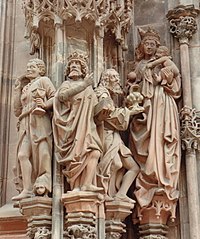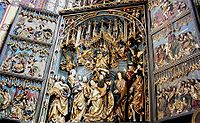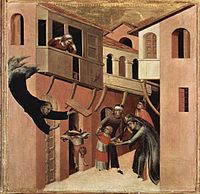Gothic art



- This article is about Gothic art. See also Gothic architecture
Gothic art was a Medieval art movement that lasted about 200 years. It began in France out of the Romanesque period in the mid-12th century, concurrent with Gothic architecture found in Cathedrals. By the late 14th century, it had evolved towards a more secular and natural style known as International Gothic, which continued until the late 15th century, where it evolved into Renaissance art. The primary Gothic art mediums were sculpture, panel painting, stained glass, fresco and illuminated manuscript.
Overview
Gothic art told a narrative story through pictures, both Christian and secular.
The earliest Gothic art was Christian sculpture, born on the walls of Cathedrals and abbeys. Christian art was often typological in nature (see Medieval allegory), showing the stories of the New Testament and the Old Testament side by side. Saints' lives were often depicted. Images of the Virgin Mary changed from the Byzantine iconic form to a more human and affectionate mother, cuddling her infant, swaying from her hip, and showing the refined manners of a well-born aristocratic courtly lady.
Secular art came in to its own during this period with the rise of cities, foundation of universities, increasing trade, a money-based economy and a bourgeois class who could afford to patronize the arts and commission works resulting in a proliferation of paintings and illuminated manuscripts. Increased literacy and a growing body of secular vernacular literature encouraged the representation of secular themes in art. With the growth of cities, trade guilds were formed and artists were often required to be members of a painters' guild—as a result, because of better record keeping, more artists are known to us by name in this period than any previous, some artists were even so bold as to sign their names.
Gothic sculpture
Gothic sculpture was born on the wall, in the middle of the 12th century in Île-de-France, when Abbot Suger built the abbey at St. Denis (ca. 1140), considered the first Gothic building, and soon after the Chartres Cathedral (ca. 1145). Prior to this there had been no sculpture tradition in Ile-de-France—so sculptors were brought in from Burgundy, who created the revolutionary figures acting as columns in the Western (Royal) Portal of Chartres Cathedral (see image)—it was an entirely new invention, and would provide the model for a generation of sculptors.
The French ideas spread. In Germany, from 1225 at the Cathedral in Bamberg onward, the impact can be found everywhere. The Bamberg Cathedral had the largest assemblage of 13th century sculpture, culminating in 1240 with the Bamberg Rider, the first equestrian statue in Western art since the 6th century. In England the sculpture was more confined to tombs and non-figurine decorations (which can in part be blamed on Cistercian iconoclasm). In Italy there was still a Classical influence, but Gothic made inroads in the sculptures of pulpits such as the Pisa Baptistery pulpit (1269) and the Siena pulpit. A late mastework of Italian Gothic sculptures is the series of Scaliger Tombs in Verona (early-late 14th century).
Gothic sculpture evolved from the early stiff and elongated style, still partly Romanesque, into a spatial and naturalistic feel in the late 12th and early 13th century. Influences from surviving ancient Greek and Roman sculptures were incorporated into the treatment of drapery, facial expression and pose.
Dutch-Burgundian sculptor Claus Sluter and the taste for naturalism signaled the beginning of the end of Gothic sculpture, evolving into the classicistic Renaissance style by the end of the 15th century.

Gothic painting
Painting in a style that can be called "Gothic" did not appear until about 1200, or nearly 50 years after the start of Gothic architecture and sculpture. The transition from Romanesque to Gothic is very imprecise and not at all a clear break, but we can see the beginnings of a style that is more somber, dark and emotional than the previous period. This transition occurs first in England and France around 1200, in Germany around 1220 and Italy around 1300.
Painting (the representation of images on a surface) during the Gothic period was practiced in 4 primary crafts: frescos, panel paintings, manuscript illumination and stained glass. Frescoes continued to be used as the main pictorial narrative craft on church walls in southern Europe as a continuation of early Christian and Romanesque traditions. In the north stained glass was the art of choice until the 15th century. Panel paintings began in Italy in the 13th century and spread throughout Europe, so by the 15th century they had become the dominate form supplanting even stained glass. Illuminated manuscripts represent the most complete record of Gothic painting, providing a record of styles in places where no monumental works have otherwise survived. Painting with oil on canvas does not become popular until the 15th and 16th centuries and was a hallmark of Renaissance art.
Gallery
-
Detail of the Garden of Gethsemane from the Ulmer Münster
-
Moses on the baptismal font by the sculptor Christoph von Urach, Church of Saint Amandus, Bad Urach, 1518
Gothic artists
Significant Gothic artists, listed chronologically.
- Mastro Guglielmo 12th Century Italian Sculptor
- Maestro Esiguo 13th Century
- Master of the Franciscan Crucifixes 13th Century Italian
- Benedetto Antelami 1178-1196 Italian Sculptor
- Bonaventura Berlinghieri 1215-1242 Italian Painter de:Bonaventura Berlinghieri
- Nicola Pisano 1220-1284 Italian Sculptor
- Fra Guglielmo 1235-1310 Italian Sculptor
- Guido Bigarelli 1238-1257 Italian Sculptor
- Giovanni Pisano 1250-1314 Italian Sculptor
- Duccio di Buoninsegna 1255-1318 Italian Painter
- Lorenzo Maitani 1255-1330 Italian Sculptor/Architect
- Arnolfo di Cambio 1264-1302 Italian Sculptor
- Master of San Francesco Bardi 14th Century Italian Painter
- Master of San Jacopo a Mucciana 14th Century Italian
- Simone Martini 1285-1344 Italian Painter
- Tino da Camaino 1285-1337 Italian Sculptor
- Evrard d'Orleans 1292-1357 French Sculptor
- Andrea Pisano 1295-1348 Italian Sculptor
- Jacopo del Casentino 1297-1358 Italian Painter
- Segna di Buonaventure 1298-1331 Italian Painter
- Giovanni da Balduccio 1300-1360 Italian Sculptor
- Jean Pucelle 1300-1355 French Manuscript Illuminator
- Goro di Gregorio 1300-1334 Italian Sculptor
- Gano di Fazio 1302-1318 Italian Sculptor
- Vitale da Bologna 1309-1360 Italian Painter
- Agostino di Giovanni 1310-1347 Italian Sculptor
- Allegretto Nuzi 1315-1373 Italian Painter
- Giottino 1320-1369 Italian Painter
- Giusto de Menabuoi 1320-1397 Italian Painter
- Puccio Capanna 1325-1350 Italian Painter
- Altichiero 1330-1384 Italian Painter
- Bartolo di Fredi 1330-1410 Italian Painter
- Peter Parler 1330-1399 German Sculptor
- Andre Beauneveu 1335-1401 Netherlandish Painter/Sculptor
- Master of the Dominican Effigies 1336-1345 Italian Painter
- Niccolo di Pietro Gerini ca. 1340-1414 Italian Painter
- Guariento di Arpo 1338-1377 Italian Painter
- Jacobello Dalle Masegne Died 1409 Italian Sculptor
- Giovanni da Campione 1340-1360 Italian Sculptor
- Master of the Rebel Angels 1340 French Painter
- Andrea da Firenze 1343-1377 Italian Painter
- Nino Pisano 1343-1368 Italian Painter/Sculptor
- Puccio di Simone 1345-1365 Italian Painter
- Nicolo da Bologna 1348-1399 Italian
- Bonino da Campione 1350-1390 Italian Sculptor
- Luis Borrassa 1350-1424 Spanish Painter
- Jacquemart de Hesdin 1350-1410 French Miniaturist
- Giovanni da Milano 1350-1369 Italian Painter
- Master of the Rinuccini Chapel 1350-1375 Italian
- Claus Sluter 1350-1406 Flemish Sculptor
- Giovanni Bon 1355-1443 Italian Sculptor/Architect
- Melchior Broederlam 1355-1411 Netherlandish Painter
- Giovanni del Biondo 1356-1399 Italian Painter
- Gherardo Starnina 1360-1413 Italian Painter
- Jean de Liege 1361-1382 Flemish Sculptor
- Taddeo di Bartolo 1362-1422 Italian Painter
- Jean Malouel 1365-1415 Netherlandish Painter
- Gentile da Fabriano 1370-1427 Italian Painter
- Lorenzo Monaco 1370-1425 Italian Painter
- Stefano da Verona 1375-1438 Italian Painter
- Master of Saint Veronica 1395-1420 German Painter
- Fra Angelico 1395-1455 Italian Painter
- Jacopo Bellini 1400-1470 Italian Painter
- Hermann Jean and Paul Limbourg 1400 Netherlandish Manuscript Illuminator
- Master of the Berswordt Altar 1400 German Painter
- Henri Bellechose 1415-1440 Flemish Painter
- Bernt Notke ca. 1435-1508 German Sculptor and Painter
See also
- Renaissance of the 12th century
- International Gothic
- Blackletter (also known as Gothic script)
- The Ten Virgins
- Danse Macabre
- History of Painting
- Western painting
External links
- Gothic art, from ArtCyclopedia.com
- Gothic art, from Encyclopedia Britannica Online.
- Gothic art, from Microsoft Encarta.
- Gothic art, from The Columbia Encyclopedia, Sixth Edition. 2001.
- Gothic art, Museumsportal Schleswig-Holstein
- Gothic art, from "A World History of Art" and [1].Template:Link FA





